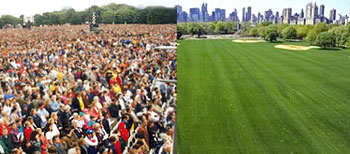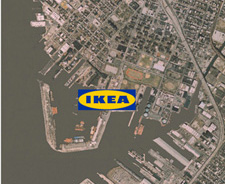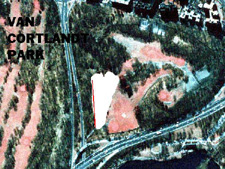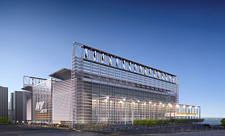Why Protestors Need the Great Lawn
|
Related Articles: Louie Jones: Why Poor People Will Take to the Streets Suneel(a) Mubayi: Going Beyond Mass Protest The Rally Threatens The Beautifully Restored Lawn |
New York City and the Department of Parks and Recreation have denied United for Peace and Justice a permit for approximately 250,000 people to protest the Republican National Convention and hold a rally on the Great Lawn in Central Park on August 29.
As an organizer of the rally, I understand that the city faces a tremendous challenge with the Republicans coming to town. We are mindful of this and feel that we have proposed the simplest, most clear-cut and safest way for New Yorkers and people from across the country to exercise our First Amendment rights.
The convention will be at Madison Square Garden. We filed for a permit that would allow us to march up Eighth Avenue past the Garden and then continue to Central Park West and into Central Park.
There are few open spaces in Manhattan where large groups of people can congregate within walking distance of Madison Square Garden. The Great Lawn is ideal. This area of the park can handle large crowds. It has held concerts by the New York Philharmonic and Metropolitan Opera, and other events like a visit from Pope John Paul II in 1995.
We are seeking a permit for the entire Great Lawn, not just the oval in the middle. Around the oval are six ball fields and room for people to gather and hear the rally.
The city has suggested that we move the march to Flushing Meadow Park in Queens. This is not acceptable. We should be allowed to protest near the convention and make our concerns heard.
The fact that we were denied a permit, although upsetting, is not surprising. When we were organizing the February 15, 2003 rally against the war in Iraq, we put in a request to march past the United Nations on First Avenue. The city adamantly refused to grant us the right to march anywhere in Manhattan.
I still do not understand the logic of that decision from a safety or a public relations point of view. The only explanation I can imagine is that officials were trying to confuse people and undermine the effectiveness of the demonstration.
I am not saying that the city is doing the same this time, but we are concerned about the city’s political agenda. In the last several years, it has become more difficult to get permits to march in New York City. And the dynamics between police and demonstrators have grown worse. Is it just a coincidence that a Republicans are coming to town and our Republican mayor has denied a permit to march?
My hope is that city officials will come to their senses and allow us to march and rally. We have already launched a national campaign to put pressure on the mayor, who should recognize that this is the best plan for the day.
But one way or another we are going to protest. They will not silence us.
Leslie Cagan is a co-chair of United for Peace and Justice.
A Mass Rally Could Destroy the Great Lawn
|
Related Articles: Louie Jones: Why Poor People Will Take to the Streets Suneel(a) Mubayi: Going Beyond Mass Protest Protesters Have A Right To Use The Park |
Central Park is over 150 years old. If over the years all the schemes to construct buildings and hold events in the park had been accepted, there would be no park left today.
Now the park faces a new threat. An organization opposed to U.S. foreign policy wants to use the Great Lawn for a rally the day before the Republican National Convention. They anticipate an attendance of 250,000, including many out-of-towners who will have traveled to New York City to participate.
The purpose of the event has no relation to the decision on the use of the park, except as it affects the likely conduct of the demonstrators. The Great Lawn would not be an appropriate site for a memorial service for Ronald Reagan, which would attract a vastly different crowd.
The Great Lawn is a very different place than it was in 1982 when it was the site of a huge anti-nuclear rally. The last two mass events on the Great Lawn – the premiere of the Disney movie Pocahontas and Pope John Paul 11’s visit – took place in 1995. Shortly after the pope’s visit, the city began a major restoration of the area.
Today, the lawn cannot accommodate hundreds of thousands of people. Its limit is about 85,000, with everyone standing. The overflow would overwhelm adjacent areas of the park, hurting trees and shrubs. In addition, the thousands who would have to be turned away would swarm over Fifth Avenue and Central Park West, blocking traffic and most likely expressing frustration at being excluded from watching the events.
The restoration of the Great Lawn included the installation of an underground drainage system to deal with water that came from the former reservoir on the site, a surface drainage system to keep rainwater from forming ponds on the lawn, and an irrigation system with almost two miles of piping to keep the grass green. That elaborate substructure for irrigation and drainage would be jeopardized by intense use.
During the restoration, the lawn was covered with 25,000 cubic yards of topsoil and planted with five varieties of Kentucky bluegrass, with a sprinkling of perennial. To give the roots a chance to penetrate nine inches deep into the sandy loam topsoil, the lawn was closed to the public for nine months. This grass is likely to be highly disturbed by thousands of people standing on it for several hours. It would take a long time to heal.
It cost $18.2 million to renovate the lawn. Some of the funds came from private contributions. How can the city ask citizens for money to restore the park if it will be destroyed when an enormous crowd holds an event?
And this would not be the last such gathering. The courts are very protective of First Amendment rights, as they should be. If the city grants a permit for one political event on the Great Lawn, it will be hard pressed to deny permits to any other group that wants to express its views. That means the lawn would be repeatedly trampled, with each successive event doing additional damage.
There are ample alternate sites for the proposed rally. Dag Hammarskjold Park, across from the United Nations, has been a traditional forum area. If needed, the crowd can overflow onto adjacent streets. If that site is not sufficient, the protest could be held in Flushing Meadows- Corona Park. That park offers unlimited space, and access to transportation. It was also an early site of the United Nations General Assembly.
Natural areas should be protected from exploitation for transitory purposes. In particular, people devoted to peace, justice and the environment should not threaten or injure the existing environment in order to attract public attention to their cause.
The restoration of the Great Lawn transformed a dust bowl into an extraordinary landscape and a pastoral retreat for city dwellers and visitors. Today the Great Lawn is home to 92 trees, including American and English elms, red and sugar maples, four varieties of oaks, silver and little leaf lindens, and flowering crabapples and cherry trees. Salamanders, fish and frogs live in Turtle Pond's clean waters, and turtles sunbathe on its banks.
Both the city and the Department of Parks & Recreation will co-operate to offer alternate sites for the rally in a large park or public place. We Americans are proud of the civil liberties that we, unlike other less fortunate people around the world, enjoy. For a century and a half, New Yorkers have enjoyed the unusual delicacy of Central Park, with the Great Lawn recently restored to exceptional beauty. With good judgment, we can have both civic beauty and civil liberties, without infringing on either.
Henry Stern is former Commissioner of the New York City Department of Parks and Recreation%3ꄨ›p>
Debating Jobs and Economic Development
Everyone agrees: New York needs jobs.
But when it comes to the specific projects that politicians and developers promise will create them, the issue often becomes more complicated and controversial, particularly for those who live in a neighborhood that will be changed as a result.
In recent months, the city has approved two such projects: a giant IKEA furniture store in Red Hook, Brooklyn and a water filtration plant in Van Cortlandt Park in the Bronx. And in coming months, the fate of another huge project - the development of the West Side of Manhattan that includes a new football stadium for the New York Jets - will also be decided.
Supporters of each of these projects promise that they will bring much-needed jobs to the city. But opponents question such promises and point to the cost to taxpayers, the increase in traffic, and scourge of pollution that come along with new them.
The details and plans of such projects lie largely with the mayor and the city's Department of City Planning, which is responsible for the city's physical planning and review process.
But it is the local City Council member - who is elected by just a few thousand people - has the most to gain or lose politically. Individual council members often use their power over land use decisions and zoning as well as their "bully pulpit" to help shape economic development proposals.
Here are three new economic development projects that will reshape the city and a look at what City Council members on both sides have to say about each.
Brooklyn IKEA Furniture Store
|
|
YES: Why Brooklyn Needs IKEA - Sarah Gonzalez
Councilmember Sarah Gonzalez, who represents the neighborhood where the new IKEA will be built, argues that "there hasn't been an investment of this size in Red Hook since World War II."
NO: Companies Must Share Our Values - Charles Barron
East New York Councilmember Charles Barron argues that companies can do more to help local residents. "We don't talk about the fact that IKEA is a Swedish company from a country where 90 percent of the workers are unionized," he says, and "none of the IKEA workers in America are unionized."
Bronx Water Filtration Plant
|
|
YES: A Legacy Investment - Madeline Provenzano
YES: Job Creation for Future Generations - Joel Rivera
Bronx council members Madeline Provenzano and Joel Rivera say that Van Cortlandt Park is the best place to build a new water filtration plant for the city. "We need to provide a job creation program to ensure that future generations will be able to put food on their plate, clothing on their back, and be able to pay the rent," says Rivera.
NO: Wrong Place, Wrong Time - Oliver Koppell
NO: Jobs Don't Trickle Down - Helen Foster
Bronx council members Oliver Koppell and Helen Foster say the filtration plant should be built elsewhere. "The promise of jobs is a red herring," says Koppell. "This is a project being built in the wrong place at the wrong time."
West Side Stadium and Convention Center
|
|
YES: Time To Develop the West Side - David Weprin
Councilmember David Weprin, who chairs the council's finance committee, argues that the plan to develop the West Side, expand the Javits Convention Center, and build a new stadium for the New York Jets is "an opportunity to leverage private investment to create jobs and economic growth."
NO: Stop the Stadium - Christine Quinn
West Side council member Christine Quinn argues that the Jets stadium will be "the most expensive stadium ever built" and that 21,000 people who live in the area are not being given a chance to say in the future of their neighborhood.








